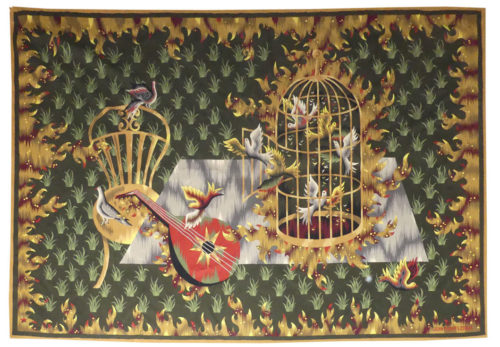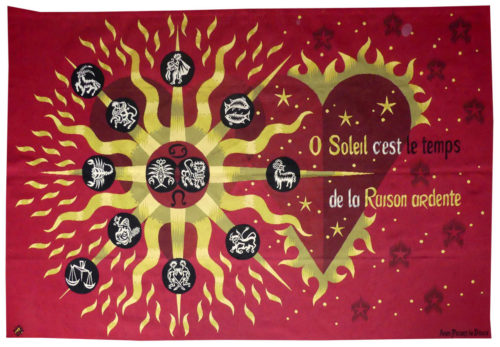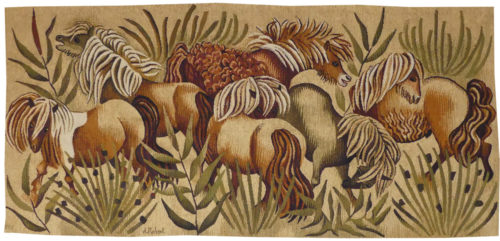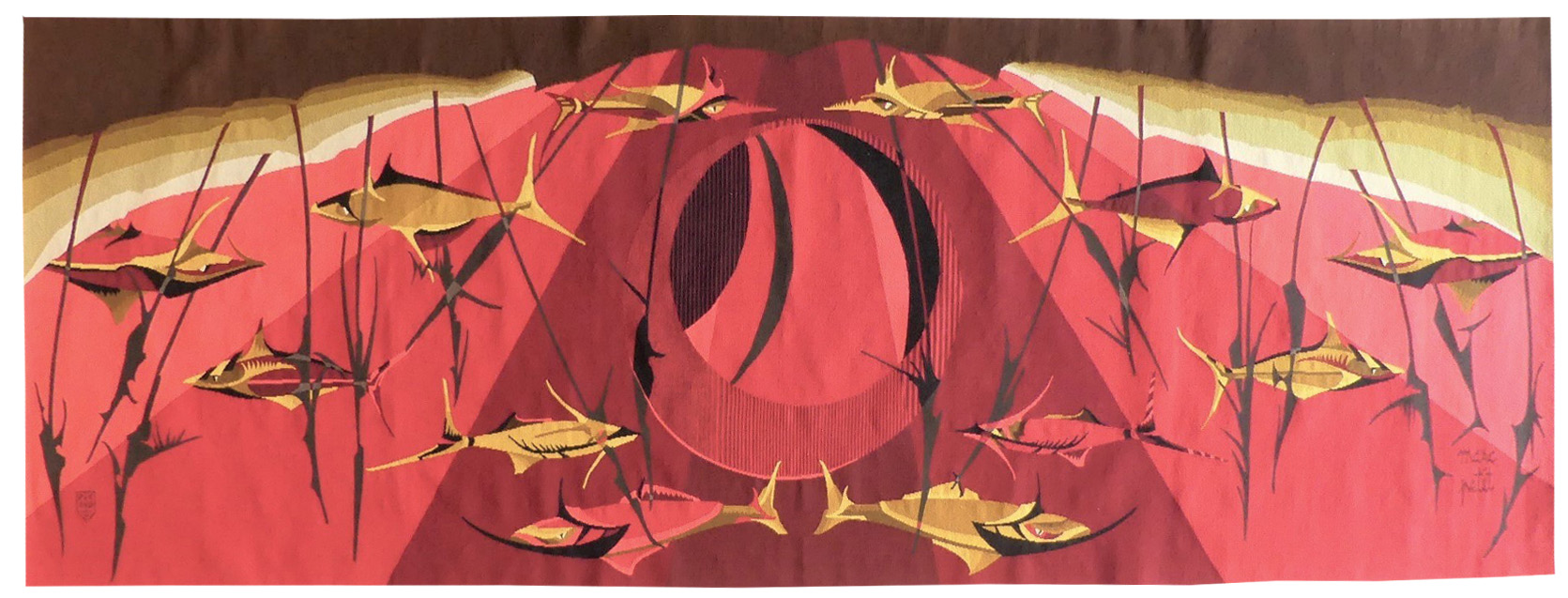-
Ô soleil (O Sun)
Aubusson tapestry woven by the Hamot workshop. With signed label, n°2/8. 1968. Jean Picart le Doux is one of the foremost figures in the renaissance of the art of tapestry. His earliest contributions to the field date back to 1943 when he designed cartoons for the passenger ship “la Marseillaise”. A close associate of Lurçat, whose theories he would adopt (limited palette, numbered cartoons...), he was a founding member of the A.P.C.T. (Association des Peintres-cartonniers de Tapisserie), and soon after, a teacher at the Ecole Nationale Supérieure des Arts Décoratifs. The state gave him several commissions most of them at the Aubusson workshop, and some at the Gobelins : the most spectacular of these being for the University of Caen, the Theatre in Le Mans, the passenger ship France or the Prefecture of the Creuse département ... In as much as Picart le Doux’s aesthetic is close to that of Lurçat, so also is his inspiration and his subject matter, although in a register which is more decorative than symbolic, where he brings together heavenly bodies (the sun, the moon, the stars...), the elements, nature (wheat, vines, fish, birds...), man, literary quotation ... « The inclusion of text constitutes a closer means of communication with the poet” says Picart le Doux (a process used also by Lurçat) who will quote Apollinaire as here (“la jolie rousse”) but also Whitman, Eluard, Saint John Perse,... Illustrated by an ardent heart and, in a literal reflection of the text, by the sun, he associates the zodiac, one of his recurrent motifs, with the love poem. Bibliography : Maurice Bruzeau, Jean Picart le Doux, Murs de soleil, Editions Cercle d’art, 1972, ill. n°161 Exhibition Catalogue, Jean Picart le Doux, tapisseries, Musée de Saint-Denis, 1976 Exhibition Catalogue Jean Picart le Doux, Musée de la Poste, 1980 -
Aubusson tapestry woven in the Novion workshop. With label. 1973.A Benedictine monk and an illuminator, Dom Robert met Jean Lurçat in 1941 at the Abbey of En Calcat : while he never abandoned drawing (his watercolours, painted to life, would serve him as a reservoir of ideas for his tapestries), his work as a cartoonist (he was a member of the A.P.C.T. from its inception) would take on a considerable importance (at least a hundred cartoons, all numbered) and would be highly thought of. His immediately recognisable style, absence of perspective¸motifs inspired from the natural world (in a Paradisiac style) where stylised flora and fauna combine in a festive and extrovert exuberance, where the influence of mediaeval tapestry can be clearly felt ; poetic and colourful, Dom Robert’s cartoons are the incarnation of their author’s spiritual asceticism. Inaugurated in the Spring of 2015, the musée Dom Robert opened its doors in in the monastery-school in Sorèze in the department of the Tarn. Although the theme of horses runs through a lot of Dom Robert’s work (cf. “Dartmoor”, “Compagnons de la Marjolaine”, « Farfadet » …), what makes « Technique de groupe » particularly interesting is its origin and the technical aspects of its realisation : unusually, this cartoon is not numbered ; it was Novion, at the time a teacher at the Ecole Nationale d’Art Décoratif in Aubusson, who asked dom Robert to make a watercolour (now held at the museum in Sorèze), thus allowing the weaver more interpretative freedom, and a very different end result, from work made by the workshops of Goubely or Tabard. Bibliography : Cat. Expo. Dom Robert, tapisseries récentes, Paris, Galerie la Demeure, 1974, ill. p.9 Multi-authored, Dom Robert, Tapisseries, Editions Julliard, 1980, ill. p.68-69 Multi-authored, Dom Robert, Tapisseries, Editions Siloë-Sodec, 1990, ill. p.116-117 Exhibition Catalogue, Dom Robert, œuvre tissé, Angers, Musée Jean Lurçat et de la tapisserie contemporaine, 1990, ill. Multi-authored, la clef des champs, Dom Robert, Editions Privat, 2003, ill. p. 109
-
Escorte (escort)
Marc Petit met Jean Lurçat in 1954, went to Aubusson in 1955, exhibited his work for the first time at La Demeure in 1956, became a member of the A.P.C.T. (Association des Peintres-Cartonniers de Tapisserie) in 1958. After this lightning start to his career, he produced hundreds of cartoons, in a style all his own, where long-legged waders and acrobats wend in and out of dreamscapes. Again, economy of means, with broad flat tints and a narrow chromatic range, for a singular theme: a heavenly body at the bottom of the sea, ‘escorted’ by worrying fish, a singular dawn (a leitmotif for the artist) of life.Aubusson tapestry woven in the Picaud workshop for the Verrière gallery. With signed label, n°EA. Circa 1970. -
Conte d'hiver (the winter's tale)
Aubusson tapestry woven in the Goubely workshop. With label, n°2/4. 1963. I became interested in the art of tapestry particularly because I was excited by the numbered cartoon technique consisting of the fabrication of a mental coloured image using a code…. Tapestry is an essential exercise. As I practised it, it is perhaps the desire to interrogate, down to the finest detail, a work which exists in two dimensions.” (quoted in the exhibition catalogue, Prassinos, rétrospective de l’oeuvre peint et dessiné, Puyricard, 1983). So much for the artist’s manifesto. Prassinos designed his first cartoons in 1951 (most of which, around 150, would be woven in the Goubely workshop); then he joined the A.P.C.T. (Association des Peintres-Cartonniers de Tapisserie). After several cartoons taking birds as their theme, Prassinos, like several other artists, despite being close to Lurçat, (Matégot, Wogensky…) turned resolutely towards abstraction, in a very personal style where sinuous shapes entwine in contrasting colours (often following a scheme of black-red-brown-beige). Bibliography : Exhibition catalogue Mario Prassinos, tapisseries monumentales, Abbaye de Montmajour, Arles, 1974 Mario Prassinos, œuvre tissé, La Demeure, 1974, n°53 Exhibition catalogue Mario Prassinos, Tapisseries , Aubusson, Musée départemental de le Tapisserie, 1984, ill. p.23 Exhibition catalogue Prassinos, Tapisseries, Angers, Musée Jean Lurçat et de la Tapisserie Contemporaine, 1988






